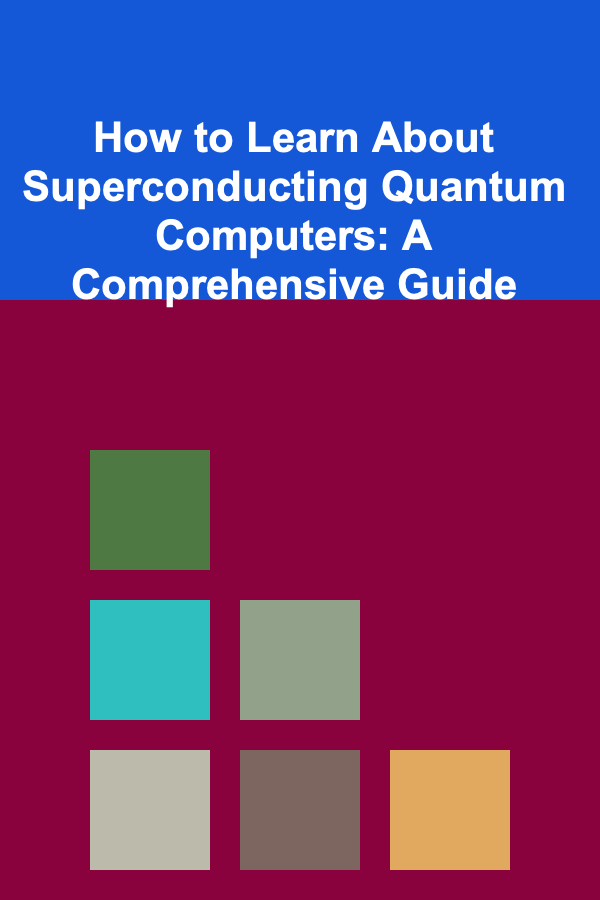
How to Learn About Superconducting Quantum Computers: A Comprehensive Guide
ebook include PDF & Audio bundle (Micro Guide)
$12.99$7.99
Limited Time Offer! Order within the next:

The world of quantum computing is rapidly evolving, and superconducting quantum computers are at the forefront of this technological revolution. Understanding these complex systems requires a multidisciplinary approach, encompassing physics, computer science, and electrical engineering. This comprehensive guide aims to provide a structured pathway for anyone interested in delving into the intricacies of superconducting quantum computers, from absolute beginners to those with some prior knowledge.
Phase 1: Foundational Knowledge -- Laying the Groundwork
Before diving into the specifics of superconducting qubits, it's crucial to establish a solid foundation in the underlying principles. This involves understanding the core concepts of quantum mechanics and the basics of conventional computers.
1. Quantum Mechanics Fundamentals:
Quantum mechanics governs the behavior of matter at the atomic and subatomic levels. Several key concepts are essential:
- Superposition: Unlike classical bits that can be either 0 or 1, a qubit can exist in a superposition, a probabilistic combination of both states simultaneously. This is often represented using Dirac notation:
|ψ⟩ = α|0⟩ + β|1⟩, where α and β are complex numbers representing the probability amplitudes. - Entanglement: This is a uniquely quantum phenomenon where two or more qubits become linked, such that the state of one qubit instantaneously influences the state of the others, regardless of the distance separating them. Entanglement is crucial for many quantum algorithms.
- Quantum Measurement: When a qubit is measured, its superposition collapses into a definite state (either 0 or 1). The probability of measuring a specific state is determined by the square of the amplitude associated with that state (|α|² for |0⟩ and |β|² for |1⟩).
- Quantum Gates: Analogous to logic gates in classical computers, quantum gates manipulate the state of qubits. These gates are represented by unitary matrices. Examples include the Hadamard gate (H), the Pauli-X gate (X), and the CNOT gate.
Resources:
- Introductory Physics Textbooks: Many introductory physics textbooks cover basic quantum mechanics principles. Look for chapters on wave-particle duality, the Schrödinger equation, and the Heisenberg uncertainty principle.
- Online Courses: Platforms like Coursera, edX, and Udacity offer excellent introductory quantum mechanics courses. Look for courses that specifically cover superposition, entanglement, and quantum measurement.
- Books:
- "Quantum Mechanics: Concepts and Applications" by Nouredine Zettili
- "Introduction to Quantum Mechanics" by David J. Griffiths
2. Classical Computing Basics:
Understanding the fundamentals of classical computing is crucial for appreciating the advantages and differences of quantum computers. Key concepts include:
- Bits and Logic Gates: Understand how information is represented as bits (0 and 1) and how logic gates (AND, OR, NOT, XOR) operate on these bits to perform computations.
- Computer Architecture: Gain a basic understanding of the components of a computer, including the CPU, memory, and input/output devices.
- Algorithms and Data Structures: Familiarize yourself with fundamental algorithms (sorting, searching) and data structures (arrays, linked lists, trees).
Resources:
- Introductory Computer Science Textbooks: Many introductory computer science books will cover these basics.
- Online Courses: Platforms like Khan Academy and Codecademy offer free courses on computer science fundamentals.
- Books:
- "Computer Science: A Structured Programming Approach Using C" by Behrouz A. Forouzan and Richard F. Gilberg
- "Introduction to Algorithms" by Thomas H. Cormen, Charles E. Leiserson, Ronald L. Rivest, and Clifford Stein
Phase 2: Diving into Superconducting Qubits
With a solid foundation in quantum mechanics and classical computing, you can now start exploring the specific technology of superconducting qubits. This involves understanding the physical principles behind them, their advantages and disadvantages, and the different types of superconducting qubits.
1. Superconductivity:
Superconductivity is a phenomenon where certain materials exhibit zero electrical resistance below a critical temperature. This allows for lossless current flow and the creation of quantum circuits with minimal dissipation.
- Cooper Pairs: In a superconductor, electrons form Cooper pairs due to interactions with lattice vibrations (phonons). These Cooper pairs behave as bosons and can condense into a macroscopic quantum state.
- Josephson Junctions: A Josephson junction consists of two superconducting materials separated by a thin insulating barrier. It allows Cooper pairs to tunnel through the barrier, leading to a supercurrent.
Resources:
- Solid State Physics Textbooks: Look for chapters on superconductivity and Josephson junctions.
- Online Resources: Search for articles and videos explaining the basics of superconductivity.
- Hyperphysics: Excellent website for physics concepts.
- Books:
- "Solid State Physics" by Neil W. Ashcroft and N. David Mermin
- "Principles of Superconductive Devices and Circuits" by Theodore Van Duzer and Charles W. Turner
2. Types of Superconducting Qubits:
Several different types of superconducting qubits have been developed, each with its own advantages and disadvantages. The most common types include:
- Transmon Qubits: Transmon qubits are the most widely used type of superconducting qubit. They are relatively insensitive to charge noise, making them more stable than earlier designs. They are based on a Josephson junction shunted by a large capacitor.
- Flux Qubits: Flux qubits are based on a superconducting loop interrupted by Josephson junctions. The qubit's state is determined by the direction of circulating current in the loop.
- Phase Qubits: Similar to flux qubits, phase qubits rely on the phase difference across Josephson junctions to define the qubit state.
- Xmon Qubits: A variant of the transmon qubit that improves connectivity and reduces crosstalk.
Resources:
- Research Papers: Read research papers published in journals like Physical Review Letters, Nature, and Science to learn about the latest advancements in superconducting qubit technology. Start with review papers.
- Quantum Computing Companies' Websites: Companies like IBM, Google, and Rigetti Computing often publish information about their superconducting qubit architectures.
- Online Lectures and Seminars: Many universities and research institutions offer online lectures and seminars on quantum computing.
3. Qubit Control and Readout:
To perform computations with superconducting qubits, it is necessary to be able to control their state and read out the result of the computation.
- Microwave Pulses: Microwave pulses are used to manipulate the state of superconducting qubits. The frequency and duration of the pulses determine the type of quantum gate applied.
- Resonators: Resonators are used to couple to the qubits and read out their state. The frequency of the resonator changes depending on the state of the qubit.
Resources:
- Specialized Textbooks: Look for textbooks on quantum information and quantum computing that cover qubit control and readout techniques.
- Research Papers: Research papers are the best source of information on the latest advancements in qubit control and readout.
- Quantum Computing Frameworks: Explore quantum computing frameworks like Qiskit, Cirq, and PennyLane, which provide tools for simulating and controlling quantum circuits. These frameworks often include tutorials and examples that demonstrate how to control and read out qubits.
4. Challenges in Superconducting Quantum Computing:
Superconducting quantum computers face several challenges, including:
- Decoherence: Decoherence refers to the loss of quantum information due to interactions with the environment. This is a major obstacle to building large-scale quantum computers.
- Scalability: Building systems with a large number of qubits while maintaining high fidelity and connectivity is a significant engineering challenge.
- Error Correction: Quantum error correction is necessary to protect quantum computations from errors caused by decoherence and other sources of noise.
- Calibration and Control: Precisely calibrating and controlling a large number of qubits is incredibly complex.
Resources:
- Research Papers: Stay updated on the latest research addressing these challenges.
- Conference Proceedings: Attend or review proceedings from quantum computing conferences like the American Physical Society (APS) March Meeting and the Conference on Lasers and Electro-Optics (CLEO).
- Quantum Computing Blogs and Newsletters: Follow reputable blogs and newsletters to stay informed about the latest advancements and challenges in the field.
Phase 3: Advanced Topics and Practical Application
After grasping the fundamentals, delve deeper into advanced topics and explore practical applications of superconducting quantum computers.
1. Quantum Algorithms:
Quantum algorithms are algorithms designed to run on quantum computers. Some of the most well-known quantum algorithms include:
- Shor's Algorithm: Shor's algorithm can efficiently factor large numbers, which has implications for cryptography.
- Grover's Algorithm: Grover's algorithm can efficiently search unsorted databases.
- Quantum Simulation: Quantum computers can simulate quantum systems, such as molecules and materials, more efficiently than classical computers.
- Variational Quantum Eigensolver (VQE): A hybrid quantum-classical algorithm used for finding the ground state energy of a quantum system.
- Quantum Approximate Optimization Algorithm (QAOA): Another hybrid algorithm designed for solving combinatorial optimization problems.
Resources:
- Quantum Computing Textbooks: Look for textbooks that cover quantum algorithms in detail.
- Online Courses: Take advanced quantum computing courses that focus on quantum algorithms.
- Research Papers: Read research papers that describe new quantum algorithms and their applications.
- Qiskit Textbook: The Qiskit textbook offers excellent explanations and interactive examples of various quantum algorithms.
2. Quantum Error Correction:
Quantum error correction is essential for building fault-tolerant quantum computers. It involves encoding quantum information in a way that protects it from errors.
- Surface Codes: Surface codes are a promising type of quantum error correction code that are well-suited for implementation on superconducting qubits.
- Topological Codes: Topological codes are a class of quantum error correction codes that are robust to local errors.
Resources:
- Specialized Textbooks: Look for textbooks on quantum error correction.
- Research Papers: Read research papers on the latest advancements in quantum error correction.
- Online Courses: Some advanced quantum computing courses cover quantum error correction.
3. Quantum Computing Hardware Design and Fabrication:
Understanding the hardware design and fabrication processes is crucial for appreciating the challenges and limitations of superconducting quantum computers.
- Cryogenics: Superconducting qubits require extremely low temperatures (typically a few millikelvin) to operate. Cryogenic systems are used to cool the qubits to these temperatures.
- Microwave Engineering: Microwave engineering principles are used to design and control the microwave pulses that manipulate the qubits.
- Materials Science: Materials science plays a crucial role in the fabrication of superconducting qubits and other components.
- Cleanroom Fabrication: Superconducting qubits are typically fabricated in cleanroom environments to minimize contamination.
Resources:
- Solid State Physics and Materials Science Textbooks: These textbooks provide background on the materials and fabrication techniques used in superconducting qubit development.
- Microwave Engineering Textbooks: Understand the principles of microwave circuit design and signal processing.
- Online Resources: Search for articles and videos on the fabrication of superconducting qubits.
- Visit Research Labs (If Possible): Gaining firsthand experience in a research lab can provide invaluable insights into the hardware aspects of quantum computing.
4. Using Quantum Computing Frameworks:
Quantum computing frameworks like Qiskit (IBM), Cirq (Google), and PennyLane (Xanadu) provide tools for programming and simulating quantum computers. Learning to use these frameworks is essential for practical application of quantum computing.
- Qiskit: Qiskit is a Python-based framework that provides tools for creating, simulating, and running quantum circuits on IBM's quantum computers.
- Cirq: Cirq is a Python library for writing, manipulating, and optimizing quantum circuits, and then running them on quantum computers and simulators.
- PennyLane: PennyLane is a cross-platform Python library for quantum machine learning, quantum chemistry, and quantum computing with gradients. It focuses on differentiable programming of quantum circuits.
Resources:
- Framework Documentation: Each framework has extensive documentation that provides tutorials, examples, and API references.
- Online Courses: Many online courses teach how to use these frameworks.
- Community Forums: Participate in community forums to ask questions and learn from other users.
- Example Notebooks: Most frameworks provide a collection of example notebooks demonstrating various functionalities.
5. Application Domains:
Superconducting quantum computers have the potential to revolutionize many fields, including:
- Drug Discovery: Quantum computers can simulate the behavior of molecules, which can accelerate the discovery of new drugs.
- Materials Science: Quantum computers can be used to design new materials with desired properties.
- Financial Modeling: Quantum computers can be used to improve financial models and algorithms.
- Optimization: Quantum computers can solve complex optimization problems that are intractable for classical computers.
- Cryptography: Quantum computers pose a threat to current cryptographic algorithms, but they can also be used to develop new, quantum-resistant algorithms.
Resources:
- Research Papers: Read research papers on the application of quantum computers in specific domains.
- Industry Reports: Follow industry reports on the potential impact of quantum computing.
- Conferences and Workshops: Attend conferences and workshops that focus on the application of quantum computing in specific industries.
Phase 4: Continuous Learning and Engagement
The field of superconducting quantum computing is constantly evolving. It's crucial to stay updated on the latest advancements and engage with the community.
1. Follow Leading Researchers and Institutions:
Stay informed about the work of leading researchers and institutions in the field.
- Subscribe to Journals: Subscribe to journals like Physical Review Letters, Nature, and Science.
- Follow Researchers on Social Media: Many researchers share their work and insights on social media platforms like Twitter and LinkedIn.
- Attend Conferences and Workshops: Attending conferences and workshops is a great way to learn about the latest research and network with other researchers.
2. Contribute to Open-Source Projects:
Contributing to open-source projects is a great way to learn and contribute to the community.
- Contribute to Quantum Computing Frameworks: Contribute to Qiskit, Cirq, or PennyLane.
- Develop New Quantum Algorithms: Develop new quantum algorithms and share them with the community.
- Create Educational Resources: Create tutorials, blog posts, or videos to help others learn about quantum computing.
3. Join Quantum Computing Communities:
Joining quantum computing communities can provide valuable support and networking opportunities.
- Online Forums: Participate in online forums and discussion groups.
- Local Meetups: Attend local meetups and workshops.
- Professional Organizations: Join professional organizations like the IEEE Quantum Initiative.
4. Experiment with Quantum Computing Platforms:
Take advantage of cloud-based quantum computing platforms to experiment with real quantum hardware.
- IBM Quantum Experience: Access IBM's quantum computers through the IBM Quantum Experience.
- Amazon Braket: Access quantum computers from multiple providers through Amazon Braket.
- Microsoft Azure Quantum: Access quantum hardware and simulators through Microsoft Azure Quantum.
Conclusion
Learning about superconducting quantum computers is a challenging but rewarding journey. By following this structured approach, starting with foundational knowledge and progressing to advanced topics and practical application, anyone can gain a deep understanding of this exciting technology. Remember to stay curious, be persistent, and engage with the quantum computing community. The future of computing is quantum, and the opportunities for innovation and discovery are immense.
This guide is just a starting point. As you delve deeper into the field, you'll discover new resources and pathways that are tailored to your specific interests and goals. Good luck on your quantum journey!

Becoming a Photographer: Essential Skills for Capturing Stunning Images
Read More
How to Make Money Online as an Amazon Seller
Read More
How to Organize Recipes in a Digital Cookbook Format
Read More
How to Organize Your Living Room for Entertaining Guests
Read More
How to Set Up a Pet-Friendly Kitchen
Read More
How to Soundproof a Noisy Neighbor's Apartment
Read MoreOther Products

Becoming a Photographer: Essential Skills for Capturing Stunning Images
Read More
How to Make Money Online as an Amazon Seller
Read More
How to Organize Recipes in a Digital Cookbook Format
Read More
How to Organize Your Living Room for Entertaining Guests
Read More
How to Set Up a Pet-Friendly Kitchen
Read More